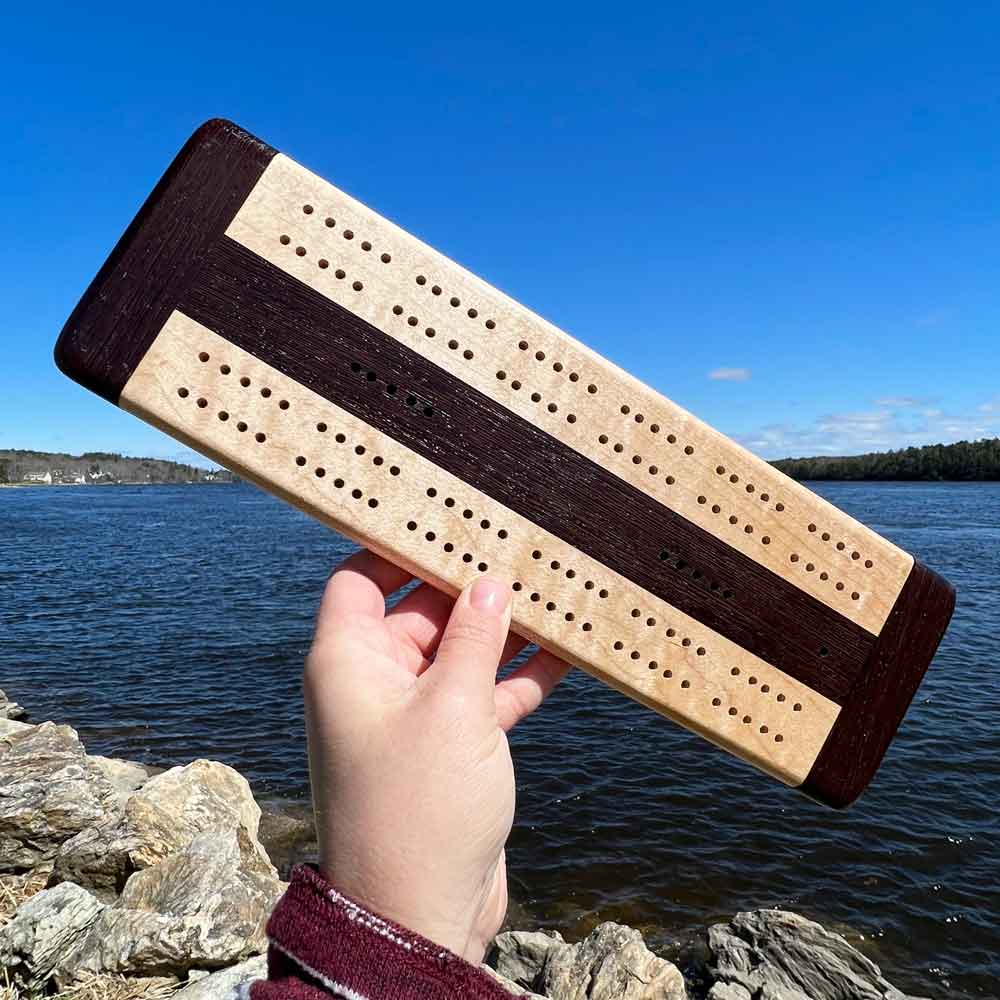Cribbage: A Test of My Skill Versus Your Luck
Okay, I’ll admit it. I am not a true Mainer. Born and raised in Rhode Island, my childhood summers consisted of family beach days in Newport and Narragansett, walks through historic Wickford Village, and late nights playing friendly games of manhunt, exploring the mystical forests that were our backyards. I took full advantage of warm weather–staying outside as long as my parents would allow, and feeling pleasantly exhausted by bedtime.
Board games were also a sporadic occurrence in our household, usually a post-dinner activity. Yahtzee, card games, Othello, Life, and Risk, were a few of the family favorites. I picked up a few of my own favorite card games in high school and college, and after moving to Maine I learned to play Parcheesi, which has become one of my personal favorite board games.
I started working at Lisa-Marie’s Made in Maine in 2017, and when I first laid eyes on one of our artist’s wooden cribbage boards I had no idea what it was. For at least a year, I was convinced it was exclusively a Maine game. Then, it came up in conversation with my mom, and she spoke of learning how to play with her grandparents at a young age. I became curious about its origin, wondering how it made its mark in Maine and whether it was popular throughout the US.
In my research, I discovered:
- Cribbage is believed to have evolved from an earlier English game called “Noddy,” and the man credited with inventing it is Sir John Suckling, a wealthy English knight, poet, playwright and gambler.
- The game allows players both the anticipation of the luck of the deal as well as ample opportunity to exercise their skills in discarding and play. Throughout a game of cribbage, a board is used to keep score instead of pen and paper. The traditional rectangular wooden board has rows of holes for pegs. The board speeds up scoring, and in this fast-moving game, pegging greatly reduces the chances for errors in adding up scores.
- FUN FACT: The scoring pegs are also known as “spilikins.” (Try saying that three times fast!)
- In England, cribbage originally was played with five cards per player, with each person putting one card into the crib. Nowadays, people play with six cards each, and each puts two cards into the crib.
- In the US, its played by more than 10 million people, primarily across the northern states, from New England to the Pacific. It’s also quite popular in Canada. In Great Britain, 1-2 million players compete in nationwide leagues.
Here I am, board game enthusiast, working in a Made in Maine shop having NEVER played a single game of cribbage. With every beautifully-crafted cribbage board sold, I remember nodding along as customers would recount memories of learning to play and teaching their own young’ins the tips and tricks of the game. “Fifteen, two, fifteen, four, pair is six…” What were they trying to say to me? What are these numbers? I had to find out. One day, while picking up necessities for a night of camping in Moosehead, I spotted a small, travel-sized classic cribbage board set and rung it up alongside trail mix and hot dog buns.
What I learned from a night of playing with my fiancé, who’s also never played, is this:
- Play your first game with someone with cribbage experience, or you’ll both be looking at each other quizzically wondering if you’re just making up rules as you go.
- Keep the instructions visible, especially during the “pegging” and “show,” to help with counting points and discovering sets of cards.
- Dust off those math skills; there are many other ways to count to fifteen than just 10+5…
- Cribbage jargon is hilarious. The slang names (which were NOT explained in the written instructions that came with our game set) were heavily (and obliviously) used as we began to catch on to the basic rules of playing:
- “You’re such a pone!“–every time the other player scored enough points to surpass pegs on the board. “Pone” is just an abbreviation of opponent, so I guess we weren’t far off.
- “One for his nobs.“–always spoken eloquently in a British accent. It gives the player one point if they are holding the Jack of the same suit of the cut card. Still not sure where the phrase comes from, but it just sounds better this way.
- “Muggins or Cutthroat“–we didn’t actually use these terms because we weren’t prepared to play at this level. Apparently, this can be an optional rule, where a player can “steal” any points that their opponent fails to count for themselves.
- “Crib, Box, or Kitty“–refers to the extra hand made up of the discarded cards. These cards count as points for the dealer during the “show.” I quickly learned that there is definitely strategy involved in what cards you give to the “crib,” depending on whether or not you yourself are the dealer.
Life is a lot like cribbage. Sometimes you get dealt a lousy hand and no combination will give you a single point, while other hands are so good you struggle to figure out how to separate the possibilities. Sometimes your partner messes up and sometimes they are your saving grace. Some combinations are a match made in heaven and others can yield only zero results.
I have played cribbage a total of five times, and am still getting the hang of things. I look forward to crisp fall evenings, pegging my points while sipping a warm mug of tea, with hopes of passing the love of the game to family members and friends. If you have any advice for a beginner player, feel free to comment below–I’d surely appreciate some insider tricks so I can win against my next challenger!

